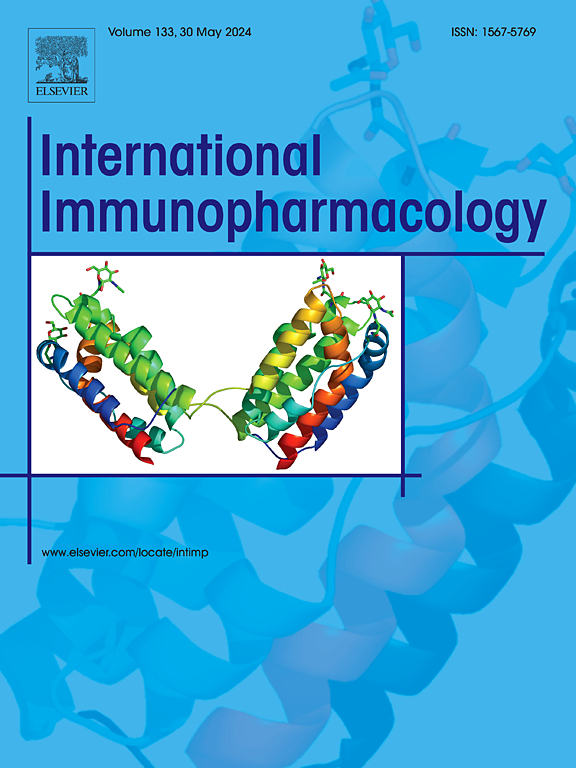分析SPRY4-IT1和TUG1在调节miR-425/TGF-β/ Smad信号介导狼疮性肾炎肾纤维化和炎症中的作用:新的生物标志物和治疗靶点
IF 4.8
2区 医学
Q2 IMMUNOLOGY
引用次数: 0
摘要
狼疮肾炎(LN)是系统性红斑狼疮(SLE)的严重并发症,由炎症和纤维化驱动,常导致慢性肾脏疾病。目前的研究旨在阐明长链非编码rna (lncRNAs) SPRY4-IT1和TUG1以及miR-425在调节TGF-β/Smad信号通路中的作用,并评估它们作为生物标志物和治疗靶点的潜力。进行了一项病例对照研究,涉及100名参与者,包括LN患者(n = 35),无LN的SLE患者(n = 35)和健康对照(n = 30)。采用qRT-PCR检测血清SPRY4-IT1、TUG1、miR-425和Smads的表达水平,ELISA检测TGF-β、纤维连接蛋白、TNF-α和PIIINP的表达水平。结果显示,与对照组相比,LN患者的SPRY4-IT1和TUG1显著上调,miR-425下调(p <;0.01)。这些ncRNAs与TGF-β、Smad2/3等纤维化标志物呈强相关,与miR-425呈负相关。ROC曲线分析表明SPRY4-IT1是最可靠的诊断标记(AUC = 0.85,敏感性= 82%,特异性= 70%)。通路分析证实它们参与炎症和纤维化过程。这些发现表明,SPRY4-IT1和TUG1通过miR-425/TGF-β/Smad轴参与LN的发病机制,强调了它们作为新的诊断和治疗靶点的潜力。在更大的队列中进行进一步的研究是必要的,以验证这些发现并探索临床应用。本文章由计算机程序翻译,如有差异,请以英文原文为准。
Dissecting the role of SPRY4-IT1 and TUG1 in modulating miR-425/TGF-β/ Smad signaling in mediating renal fibrosis and inflammation in lupus nephritis: Novel biomarkers and therapeutic targets
Lupus nephritis (LN), the severe complication of systemic lupus erythematosus (SLE), is driven by inflammation and fibrosis, often leading to chronic kidney diseases. The current study aimed to elucidate the roles of long non-coding RNAs (lncRNAs) SPRY4-IT1 and TUG1, and miR-425 in modulating the TGF-β/Smad signaling pathway and to assess their potential as biomarkers and therapeutic targets. A case-control study was conducted involving 100 participants, including LN patients (n = 35), SLE patients without LN (n = 35), and healthy controls (n = 30). Serum expression levels of SPRY4-IT1, TUG1, miR-425 and Smads were measured using qRT-PCR, while TGF-β, fibronectin,TNF-α and PIIINP were analyzed via ELISA. The results showed a significant upregulation of SPRY4-IT1 and TUG1 and a downregulation of miR-425 in LN patients compared to controls (p < 0.01). These ncRNAs demonstrated strong correlations with TGF-β, Smad2/3, and other fibrotic markers, while inversely correlating with miR-425. ROC curve analysis identified SPRY4-IT1 as the most robust diagnostic marker (AUC = 0.85, sensitivity = 82 %, specificity = 70 %). Pathway analyses confirmed their involvement in inflammatory and fibrotic processes. These findings suggest that SPRY4-IT1 and TUG1 contribute to LN pathogenesis through the miR-425/TGF-β/Smad axis, underscoring their potential as novel diagnostic and therapeutic targets. Further research in larger cohorts is warranted to validate these findings and explore clinical applications.
求助全文
通过发布文献求助,成功后即可免费获取论文全文。
去求助
来源期刊
CiteScore
8.40
自引率
3.60%
发文量
935
审稿时长
53 days
期刊介绍:
International Immunopharmacology is the primary vehicle for the publication of original research papers pertinent to the overlapping areas of immunology, pharmacology, cytokine biology, immunotherapy, immunopathology and immunotoxicology. Review articles that encompass these subjects are also welcome.
The subject material appropriate for submission includes:
• Clinical studies employing immunotherapy of any type including the use of: bacterial and chemical agents; thymic hormones, interferon, lymphokines, etc., in transplantation and diseases such as cancer, immunodeficiency, chronic infection and allergic, inflammatory or autoimmune disorders.
• Studies on the mechanisms of action of these agents for specific parameters of immune competence as well as the overall clinical state.
• Pre-clinical animal studies and in vitro studies on mechanisms of action with immunopotentiators, immunomodulators, immunoadjuvants and other pharmacological agents active on cells participating in immune or allergic responses.
• Pharmacological compounds, microbial products and toxicological agents that affect the lymphoid system, and their mechanisms of action.
• Agents that activate genes or modify transcription and translation within the immune response.
• Substances activated, generated, or released through immunologic or related pathways that are pharmacologically active.
• Production, function and regulation of cytokines and their receptors.
• Classical pharmacological studies on the effects of chemokines and bioactive factors released during immunological reactions.

 求助内容:
求助内容: 应助结果提醒方式:
应助结果提醒方式:


